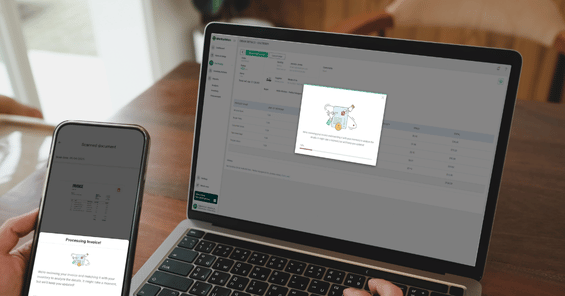

The Best Accounting Software for Restaurants
In this article, we discuss why accounting software matters in making your restaurant successful, what important features your software should have, and which software we recommend restaurants use.
It’s no secret the restaurant industry operates on razor-thin profit margins. That’s why a restaurant owner can’t take chances with their accounting practices.
But restaurant accounting is more than simply credits and debits, profits and losses. Every part of your operations ties into the financial stability of your restaurant. And your accounting should act as a hub through which all of your other processes flow.
In a survey conducted by Deloitte, 64 percent of customers stated they preferred to order digitally on premises using a QR code. And 57 percent said they preferred to order via an app for pickup and delivery.
And with constantly fluctuating food costs and high staff turnover expected in the coming few years, accounting just got a whole lot more complicated.
Six Foolproof Restaurant Cost Management Techniques
Maximize your restaurant's profitability with this essential eBook. 📈 Learn foolproof cost management techniques and unlock proven strategies for supplier negotiations and brand loyalty. 👩🍳🤝

That’s where accounting software for restaurants comes in. If it’s a good one, it will integrate seamlessly with your POS and digital payment systems, your staff management, and your ordering and inventory management tools.
Every dollar that flows in and out of your restaurant business will be accounted for automatically, streamlining your bookkeeping and making it easier to forecast for the future.
Common Terms in Restaurant Accounting
Before we dive into the what and why of restaurant accounting software, let’s take a minute to review some key terms used in restaurant accounting.
First of all, when we talk about restaurant accounting, we’re usually talking about accrual accounting rather than cash accounting. Restaurants tend to use accrual accounting, where debits and credits are recorded as soon as they occur, but before money changes hands. In cash accounting, debits and credits are only recorded once a transaction is finalized.
The IRS and the SEC require larger businesses to use accrual accounting. It also gives banks and creditors a better picture of the financial well-being of your restaurant.
Here are some other terms you should be familiar with.
- Cost of Good Sold: The total cost of food and ingredients to make each menu item.
- Prime Cost (Theoretical Cost): The total labor cost and COGS for each menu item. The best restaurant accounting software will generate a prime cost report for your restaurant.
- EBITDA: It stands for earnings before interest, taxes, depreciation, and amortization. That number measures the financial health of your restaurant, overall.
- Profit and Loss Statements (P&Ls): This report shows all money earned and spent by the restaurant over a year, quarter, month, or even week.
- Cash Flow Statements: This statement shows you where your money is going or coming from and how it affects the cash available to your restaurant.
- Balance Sheet: This statement shows you how much your restaurant is worth. It includes all assets, including inventory, as well as any debt the restaurant has.
- Restaurant Chart of Accounts: A chart of accounts is used to record all transactions (credits and debits) going in and out of your restaurant.
- Revenue Report: This is a quick view into the money that has come into your restaurant in a week, month, or quarter. You can also generate an overall report for an entire year.
You can create all these reports yourself, or you can hire an accounting professional to do it. Restaurant accounting software, however, will generate all of these reports for you automatically, based on the transactions you record.
Why do Restaurants Need Accounting Software?
When we talk about restaurant accounting, we’re talking about recording all financial data for the business in order to assess its financial health; plan quarterly, monthly, and even weekly budgets, and determine the future of business. Keeping accurate accounts is also crucial in meeting IRS regulations.
Almost no one uses pen, paper, and an accounting ledger to keep the books anymore. At the very least, you’re using an Excel or Google spreadsheet to keep your numbers.
Accounting software, however, is more time- and cost-efficient, as well as a much more accurate method. But even generic accounting software can’t cover the specific needs of a restaurant. For that, a software specifically made for restaurant accounting is essential.
Here’s how it can help you manage your money.
Tracking and Reporting
Any accounting software solution will set up accrual-based bookkeeping for your business. Income can be reported directly from a POS system to your accounting software. Payroll, vendor payments, and utility bills can also be set up and recorded automatically.
Restaurant inventory management allows you to account for and carefully manage the value of these raw materials on your balance sheet to minimize the cost of goods sold
These inventory counts are crucial in calculating the beginning and ending inventory values for specific periods and, in turn, the cost of goods sold (something discussed later).
Planning
Every decision restaurant owners make for their restaurants starts with an analysis of your accounting reports. Cash flow statements, for example, can help you determine if one aspect of the restaurant is pulling too much money out of the business. If you’re spending a lot on staff salaries, but not seeing a positive effect on revenue, it may be time to revise your staffing plans for the coming week or month.
Meanwhile, your prime cost report will give you insight into which menu items are making money and which aren’t. You can rearrange your menu, set new prices, and even cut dishes based on their prime cost against sales data.
Forecasting
Looking at monthly, quarterly, and year-over-year financial statements can help you determine how it will fare in the future. You’ll know where to invest your time and money in the future to keep your restaurant in the black.
For example, if your restaurant has lost revenue on sit-down dining YoY, you may want to invest more in delivery, or find a way to get more people through the door. If you have a restaurant in a town that depends on seasonal tourism, forecasting will help you plan for staffing up and down, as well as reduced and increased inventory orders.
Compliance
The IRS and the SEC require public U.S. businesses to use Generally Accepted Accounting Practices (GAAP). This list of requirements, set by the Financial Accounting Standards Board (FASB), dictate how businesses report their finances and how often.
Following accurate, consistent accounting practices also protects you against disputes or audits from the IRS.
Features to Look for in Restaurant Accounting Software
Before you start shopping around for restaurant accounting software, take a moment to really consider your financial goals. The software that helps you reach those goals will be the best fit for your business.
Here are some questions restaurant owners should ask when choosing restaurant accounting software:
Does it meet my restaurant’s needs? More general software programs may not account for restaurant-specific needs. The best restaurant accounting software will.
Is it user-friendly? A variety of staff members, from your head chef to your bookkeeper, may be using the software, so it should be intuitive for all users.
Will it integrate with other software systems? At the very least, accounting software should integrate with your inventory management software and point of sale system.
Is it scalable? If you expand your seating or open a new location, the best accounting software will be able to grow with your business.
Is it mobile-friendly? Your sales transactions happen via mobile, and your staff takes inventory and even accesses recipes on a mobile device. Your accounting software should do the same. You should have access to real-time numbers wherever you are via cloud accounting solutions.
Does it include automated features? Your accounting software is only as good as the amount of work it takes off your plate. If it’s just a place to store numbers, it’s not really helping you. The best accounting software services include automated tools that run P&Ls, pre-populate each invoice, and automatically update when transactions are fulfilled.
So Where’s the Best Place to Start?
If you’re already using MarketMan for your restaurant inventory, recipe management, and ordering and invoicing, take a look at our restaurant accounting partners. They integrate seamlessly with our restaurant management software:
- Virgate provides daily bookkeeping services and live dashboards for businesses in the hospitality industry.
- QuickBooks is a robust accounting software built for all types of businesses.
- ShoGo automatically posts POS and eComm sales directly to your accounting system.
- Square is an all-in-one POS system that integrates with your accounting software, as well as your inventory and restaurant management software.
- Xero is a small-business accounting solution that connects you to accountants, bookkeepers, and your bank.
Bottom line: the best restaurant accounting software should take the burden of crunching numbers off restaurant owners, restaurant managers, and their staff, while helping you make solid decisions to move your business forward. It should be intuitive for all stakeholders and integrate with your other restaurant software solutions, including inventory, POS, and payroll software, automating the work and giving you and your staff time to focus on your product and your customers.

MarketMan's restaurant inventory management software is designed to automate inventory control, reduce food costs, and optimize all back-of-house activities. By eliminating manual processes, MarketMan empowers restaurateurs to work smarter, reduce waste, and gain insights for improved profitability. Take the guesswork out of restaurant management—book a demo today to experience how MarketMan can elevate your operations!
Author
Contributors
If you have any questions or need help, feel free to reach out
Don't miss out on maximizing your restaurant's profits! Calculate your ROI with MarketMan
Join over 18,000 restaurants and get the hottest restaurant tips delivered to your inbox
You may also be interested in
Ready to get started?
Talk to a restaurant expert today and learn how MarketMan can help your business






